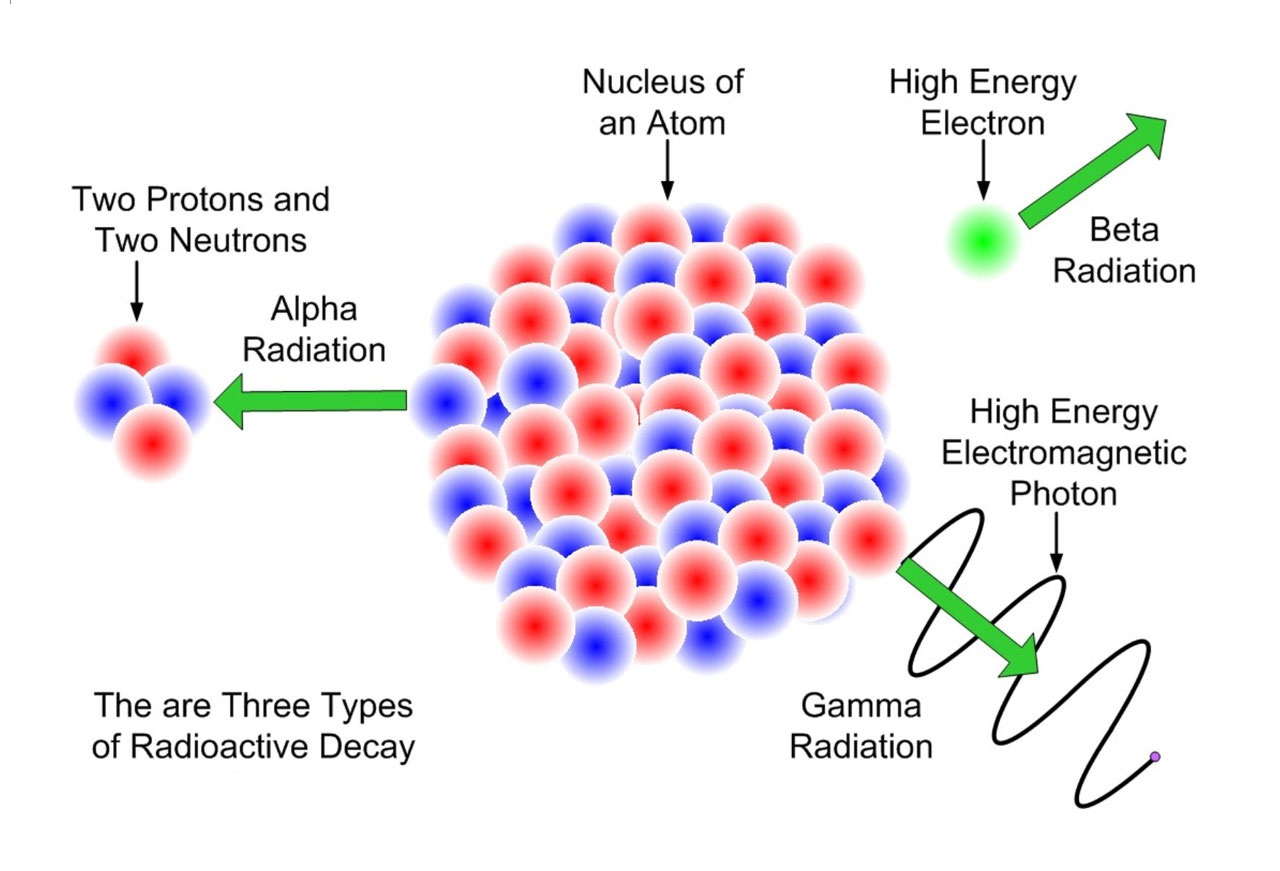Radioactive Decay
The nuclei of some elements are not stable. These nuclei are radioactive, in that they emit energy and particles, collectively called "radiation." All elements have at least some isotopes that are radioactive. All isotopes of heavy elements with mass numbers greater than 206 and atomic numbers greater than 83 are radioactive.
There are several ways in which unstable nuclei undergo radioactive decay:
- Alpha decay, which the emission of a helium-4 nucleus containing two protons and two neutrons. This is the least penetrating form of radiation. It is stopped by the dead layer of skin and so does no harm when outside the body. But it is the most damaging form of radiation when deposited inside the body.
- Beta decay, which the emission of an electron or a positron (a particle identical to an electron except that it has a positive electrical charge).
- Electron capture, which is the capture by the nucleus of an electron from among the ones whirling around it. In effect, the electron combines with a proton to yield a neutron.
- Spontaneous fission, which is the fission of a heavy element without input of any external particle or energy.

Often, there is still excess residual energy in the nucleus after the emission of a particle or after electron capture. Some of this residual energy after radioactive decay can be emitted in the form of high-frequency electromagnetic radiation, called gamma rays. Gamma rays are essentially like X-rays and are the most penetrating form of radiation. [1] It should be noted that the emission of gamma rays does not change the mass number or atomic number of the nucleus - that is, unlike radioactive decay by emission of particles, spontaneous fission, or electron capture, it does not cause the transmutation of the nucleus into another element.
Each quantum, or unit, of a gamma ray (or other electromagnetic energy) is called a photon. Gamma rays are like light, except that they are much higher frequency electromagnetic rays. Photon energy is directly proportional to the frequency of the electromagnetic radiation. Photons of gamma rays can damage living cells by splitting molecules apart or ionizing elements in them.
Many heavy nuclei emit an energetic alpha particle when they decay. For instance uranium-238 decays into thorium-234 with a half-life of almost 4.5 billion years by emitting an alpha particle:
92-uranium-238 ====> 90-thorium-234 + alpha particle (nucleus of 2-helium-4)
The mass number of uranium-238 declines by four and its atomic number by two when it emits an alpha particle. The number before the element name is the atomic number and that after the element name is the mass number. The totals of the atomic numbers and the mass numbers, respectively, on both sides of the nuclear reaction must be the same. (This is like balancing a chemical equation, in which the number of atoms of each element on both sides of the reaction must be equal)
In beta decay, the atomic number increases by one if an electron is emitted or decreases by one if a positron is emitted. For instance thorium-234, which is the decay product of uranium-238, in turn beta-decays into protactinium-234 by emitting an electron:
90-thorium-234 ====> 91-protactinium-234 + beta particle (electron)
The nuclei that result from radioactive decay may themselves be radioactive. Therefore, some radioactive elements have decay chains that may contain many radioactive elements, one derived from the other. (See Uranium Factsheet for a diagram of the decay chain of uranium-238.)
The radioactive decay of nuclei is described probabilistically. Within any given time period, a particular unstable nucleus has a fixed probability of decay. As a result, each radioactive element is characterized by a "half-life," which is the time it takes for half the initial atoms to decay (or transmute into another element or nuclear state). At the end of one half-life, half the original element is left, while the other half is transformed into another element. After two half-lives, one fourth of the original element is left; after three half-lives one eighth is left, and so on. This results in the build-up of decay products. If the decay products themselves decay into other elements, a whole host of radioactive materials come into being. The decay products of radioactive elements are also called daughter products or progeny.






